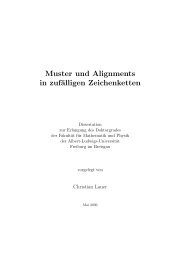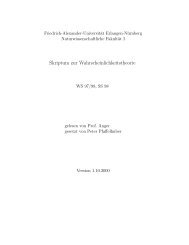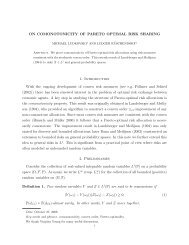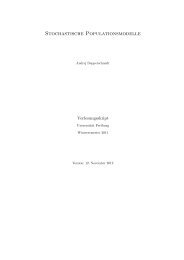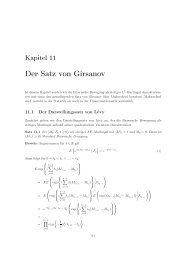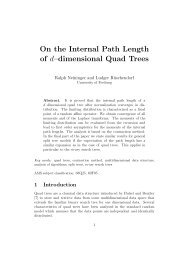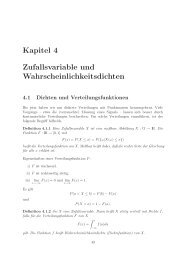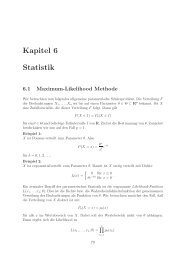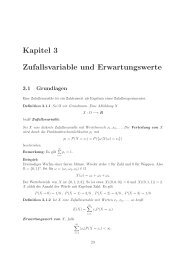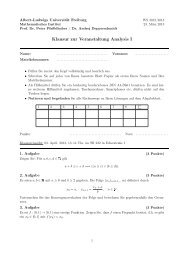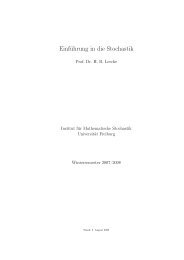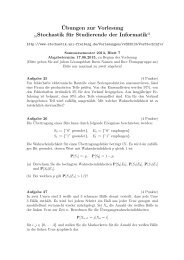Analysis of Markov chain algorithms on spanning trees, rooted ...
Analysis of Markov chain algorithms on spanning trees, rooted ...
Analysis of Markov chain algorithms on spanning trees, rooted ...
Create successful ePaper yourself
Turn your PDF publications into a flip-book with our unique Google optimized e-Paper software.
J. Fehrenbach and L. Rüschendorf 11<br />
Similary, for p ′ a ∈ (A ′ i) 0≤i≤l ∈ P Y X a and p ′ b = (B′ i) 0≤i≤l ∈ P<br />
Y X b with<br />
A ′ i =<br />
{<br />
B<br />
′<br />
i , 0 ≤ i ≤ j<br />
B ′ i ⊕ {a, b}, j < i ≤ l<br />
where again j ∈ {0, . . . , l − 1} with b ∈ A ′ j ⊕ A ′ j+1 holds F G (p ′ a) = F G (p ′ b ).<br />
Pro<str<strong>on</strong>g>of</str<strong>on</strong>g>: By definiti<strong>on</strong> <str<strong>on</strong>g>of</str<strong>on</strong>g> X a and X b , <strong>on</strong>e can easily see that the graphs M a :=<br />
(V, X a ∪ Y )/(X a ∩ Y ) and M b := (V, X b ∪ Y )/(X b ∩ Y ) are isomorph. If a<br />
c<strong>on</strong>nects the nodes w and t and b the nodes w and s in M, then I : M a → M b<br />
given by<br />
⎧<br />
⎨ v, v /∈ {v a , s}<br />
I(v) := t, v = v a<br />
⎩<br />
v b , v = s<br />
und I(e) :=<br />
{ e, e ≠ b<br />
a, e = b<br />
for all nodes v and edges e in M a defines an isomorphism. Figure ?? shows an<br />
example.<br />
t<br />
✉<br />
❚<br />
✔✔<br />
✔ ✔ ❚<br />
a ❚<br />
w<br />
✑ ✉ ❚<br />
✑✔ ✉<br />
✔ ✔ ◗ ◗◗<br />
❚<br />
✑✑ c b ❚<br />
◗❚ ✉<br />
u<br />
s<br />
M<br />
v a<br />
✉<br />
❅ ❅<br />
✉<br />
b ❅<br />
❅ ✉<br />
u<br />
s<br />
M a = (M/a) \ {c}<br />
t<br />
✉<br />
❅ ❅<br />
a ❅<br />
✉<br />
❅ ✉<br />
u<br />
v b<br />
M b = (M/b) \ {c}<br />
Figure 3: An example for a graph M from Lemma 3.1. The resulting graphs<br />
M a and M b are isomorph.<br />
The number <str<strong>on</strong>g>of</str<strong>on</strong>g> nodes in M a is the same as that in M b . The pro<str<strong>on</strong>g>of</str<strong>on</strong>g> <str<strong>on</strong>g>of</str<strong>on</strong>g> Lemma<br />
3.1 is given by inducti<strong>on</strong> over |M a |:<br />
For |M a | = 2 the path p a = (A i ) 0≤i≤1 given by A 0 = X a and A 1 = Y is the<br />
<strong>on</strong>ly path in P X a Y<br />
with a positive weight in F G<br />
, i.e. F G<br />
(p a ) = 1. The same holds<br />
for p b = (B i ) 0≤i≤1 given by B 0 = X b = (A 0 \ {a}) ∪ {b} and B 1 = Y = A 1 . So<br />
in this case the lemma is proved.<br />
If |M a | = l + 1 let D a be the set <str<strong>on</strong>g>of</str<strong>on</strong>g> nodes in M a <str<strong>on</strong>g>of</str<strong>on</strong>g> minimal degree d min<br />
and D b the analogous set <str<strong>on</strong>g>of</str<strong>on</strong>g> nodes in M b . Each node in D a corresp<strong>on</strong>ds to a<br />
node in D b via the isomorphism I.<br />
The value <str<strong>on</strong>g>of</str<strong>on</strong>g> F G<br />
(p a ) is based by c<strong>on</strong>structi<strong>on</strong> <strong>on</strong> the paths in V(p a ). For<br />
v ∈ D a each path p ′ a ∈ P ∩ V(p X a v Yv<br />
a) corresp<strong>on</strong>ds to a path p ′ b ∈ P ∩ V(p<br />
Xu b b ),<br />
Yu<br />
u := I(v) ∈ D b . Is a an edge at v in M a , so b is an edge at u in M b . This leads to<br />
Xv a = Xv b and Y v = Y u and, therefore, p ′ a = p ′ b . Otherwise, if a is not an edge at<br />
v we have v = u. In this case either X a arises from Xv a and Y v = Y or Xv a = X a<br />
and Y arises from Y v by exchanging two edges. The same holds for Xv b and Y v .<br />
This modificati<strong>on</strong> can also be d<strong>on</strong>e at X and Y and for the resulting <strong>spanning</strong>



